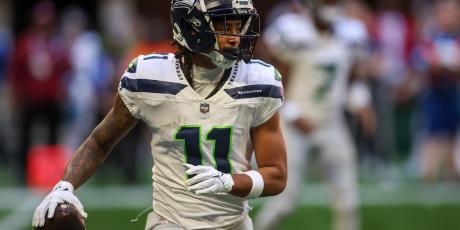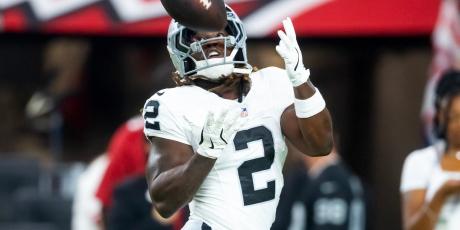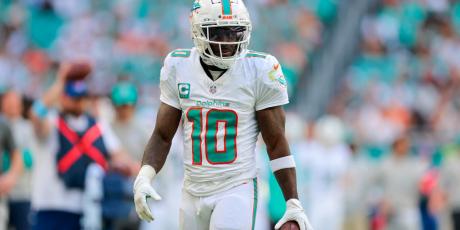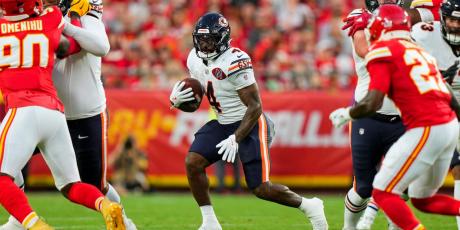Can Jerick McKinnon Make the Leap in 2018?

After letting Carlos Hyde walk this offseason, the 49ers signed Jerick McKinnon to a four-year, $30 million contract on the opening day of free agency, making him the fourth-highest paid player at his position in terms of average salary. San Francisco then ignored the running back position in April’s NFL Draft, making clear their decision to enter the 2018 season with McKinnon as their lead back.
Editor's Note: Find all our 2018 Player Profiles here.
Without ever being the featured back in an offense, what should our expectations be for McKinnon’s 2018 fantasy output?
Can Jerick McKinnon be a Workhorse Running Back?
As one of the most athletic running backs in recent history—drawing physical comparisons to LaDainian Tomlinson coming out of college—McKinnon entered the league with incredible expectations, but he has been part of a committee throughout his tenure in Minnesota. McKinnon has never handled more than 46 percent of a backfield’s carries, but his involvement in the passing game has nudged him over 200 touches in each of the last two seasons.
| Year | G | Rush Att | % of Tm | Touches | % of Backfield |
|---|---|---|---|---|---|
| 2014 | 11 | 113 | 33.6% | 140 | 33.8% |
| 2015 | 16 | 52 | 12.6% | 73 | 14.9% |
| 2016 | 15 | 159 | 46.5% | 202 | 47.6% |
| 2017 | 16 | 150 | 33.6% | 201 | 37.9% |
Since coming into the league in 2014, 23 percent of McKinnon’s touches have been through the air, the 20th-highest rate out of 75 qualifying running backs in that span (minimum 200 touches). While a running back who relies heavily on the passing game to accrue touches usually yields higher efficiency numbers than one that rarely catches the ball, McKinnon ranks 44th in both yards per carry (4.05) and yards per touch (4.71) since the beginning of 2014.
Efficiency metrics rarely paint a clear picture of a running back’s ability—or even have predictable value—but comparing teammates can be a starting point to understanding how effective a player is when given the ball. After leading his backfield in yards per touch in his first two years in the league, McKinnon fell behind at least one of his backfield mates in terms of efficiency in each of the last two seasons.
| Player | Year | Att | Yds | Yds/Att | Touches | Yds/Tch |
|---|---|---|---|---|---|---|
| Jerick McKinnon | 2014 | 113 | 538 | 4.76 | 140 | 4.81 |
| Matt Asiata | 2014 | 164 | 570 | 3.48 | 208 | 4.24 |
| Jerick McKinnon | 2015 | 52 | 271 | 5.21 | 73 | 6.08 |
| Adrian Peterson | 2015 | 327 | 1485 | 4.54 | 357 | 4.78 |
| Matt Asiata | 2016 | 121 | 402 | 3.32 | 153 | 4.35 |
| Jerick McKinnon | 2016 | 159 | 539 | 3.39 | 202 | 3.93 |
| Dalvin Cook | 2017 | 74 | 354 | 4.78 | 85 | 5.22 |
| Jerick McKinnon | 2017 | 150 | 570 | 3.80 | 201 | 4.93 |
| Latavius Murray | 2017 | 216 | 842 | 3.90 | 231 | 4.09 |
Pointing to McKinnon’s pedestrian efficiency numbers isn’t to write his death certificate as a potential featured back, though. In his first two seasons, the Vikings offensive line ranked in the top half of the league in Football Outsiders' adjusted line yards; in 2016 and 2017, their line ranked 19th and 30th, respectively. As stated before, McKinnon has the stature and athleticism of proven backs. Efficiency metrics largely revert to the league mean, and there is some precedent for running backs starting their careers as role players before switching teams and immediately becoming effective workhorse backs. See below for a few examples.
| Player | Year | Age | Tm | G | GS | Touches | PPR |
|---|---|---|---|---|---|---|---|
| Chester Taylor | 2002 | 23 | BAL | 15 | 2 | 47 | 51.1 |
| 2003 | 24 | BAL | 16 | 1 | 83 | 72.8 | |
| 2004 | 25 | BAL | 16 | 4 | 190 | 131.8 | |
| 2005 | 26 | BAL | 15 | 1 | 158 | 124.9 | |
| 2006 | 27 | MIN | 15 | 15 | 345 | 228.4 | |
| Justin Forsett | 2009 | 24 | SEA | 16 | 2 | 155 | 167.9 |
| 2010 | 25 | SEA | 16 | 5 | 151 | 122.5 | |
| 2011 | 26 | SEA | 16 | 0 | 69 | 56.3 | |
| 2012 | 27 | HOU | 16 | 0 | 66 | 50.2 | |
| 2013 | 28 | JAX | 9 | 0 | 21 | 26.3 | |
| 2014 | 29 | BAL | 16 | 14 | 279 | 244.9 | |
| Lamont Jordan | 2002 | 24 | NYJ | 14 | 0 | 101 | 82.6 |
| 2003 | 25 | NYJ | 16 | 0 | 57 | 64.1 | |
| 2004 | 26 | NYJ | 16 | 0 | 108 | 86.1 | |
| 2005 | 27 | OAK | 14 | 14 | 342 | 294.8 | |
| Michael Turner | 2004 | 22 | SDG | 14 | 1 | 24 | 15.2 |
| 2005 | 23 | SDG | 16 | 0 | 57 | 51.5 | |
| 2006 | 24 | SDG | 13 | 0 | 83 | 69.9 | |
| 2007 | 25 | SDG | 16 | 0 | 75 | 43.2 | |
| 2008 | 26 | ATL | 16 | 16 | 382 | 282.0 |
Of course, for every success story, there is a Toby Gerhart who never lived up to his new team’s expectations, but McKinnon’s situation surely isn’t unexplored territory. Maybe as important as the back himself is whether McKinnon is going to an offense that can support a top-tier fantasy running back.
How Does McKinnon Fit In Kyle Shanahan's Offense?
Kyle Shanahan has spent 10 seasons in the NFL as an offensive coordinator or head coach, but he’s been the primary playcaller for just four of those teams. The following is a snapshot of how Shanahan has used his running backs in those four seasons.
| Year | Rushes | Receptions | Total Yards | PPR FP | % of Team Touches |
|---|---|---|---|---|---|
| 2014 | 26.6 | 1.8 | 114.0 | 19.4 | 61.3% |
| 2015 | 23.9 | 6.1 | 144.9 | 26.7 | 58.2% |
| 2016 | 23.7 | 5.8 | 168.9 | 32.0 | 59.7% |
| 2017 | 22.4 | 7.1 | 144.4 | 25.8 | 61.1% |
| Year | Player | Games | Rushes | Receptions | Total Yards | PPR FP | % of RB Touches |
|---|---|---|---|---|---|---|---|
| 2014 | Terrance West | 14 | 12.2 | 0.8 | 52.6 | 8.1 | 40.1% |
| 2015 | Devonta Freeman | 15 | 17.7 | 4.9 | 108.9 | 21.1 | 70.6% |
| 2016 | Devonta Freeman | 16 | 14.2 | 3.4 | 96.3 | 17.8 | 59.5% |
| 2017 | Carlos Hyde | 16 | 15.0 | 3.7 | 80.6 | 14.7 | 63.5% |
Shanahan’s backfields have ranked in the top half of the league in terms of percentage of total team touches in each of the last four seasons. In two of those years, he has given a running back roughly two-thirds or more of those backfield touches. In other words, there are typically going to be plenty of touches to go around in a Shanahan backfield but he won’t force either a committee or a lead back.
Running back volume can be greatly impacted by game flow so it’s often best to look at how playcallers manage their offenses in neutral game script (when the game is within a single touchdown). Over the course of his play-calling career, Shanahan has run right at the league average (42.4%) in neutral game script, but San Francisco ranked 24th in that category last season, running 40.5 percent of the time.
With Jimmy Garoppolo under center for the entire season, could Shanahan slant even more towards the pass in 2018?
What Could Hurt McKinnon’s Upside?
New Quarterback, New Offense
Introducing a potential franchise quarterback into an offense might lead to assumptions that a team will be more pass-heavy than that offense without a good quarterback, but there’s little evidence to suggest the 49ers will suddenly turn into the Lions overnight. In 2017, San Francisco passed 62 percent of the time without Garoppolo under center and 53 percent with Jimmy GQ at quarterback. They also lost Pierre Garcon early in Week 8 last season—with Garcon on the field, the 49ers threw 63 percent of the time compared to 56 percent without their number one wide receiver.
Probably the most important factor to Shanahan’s pass/run splits last year, though, was wins. San Francisco won six of their final seven games, with four of those wins coming by double digits. Depending on which sportsbook you look at, the 49ers are currently projected for 8.5–9 wins, ranked in the top third of the league. Even if San Francisco fails to live up to their win expectation, McKinnon’s heavy involvement in the passing game should make him relatively immune to game flow.
Given the chance to improve their pass-catchers this offseason, the 49ers mostly stood pat—San Francisco didn’t pursue any high-profile wide receivers in free agency. While they did add a receiver early in the draft, pass-catchers rarely offer much production in their rookie campaigns.
Competition for Touches
As for the 49ers' backup running backs, there isn’t a player on the roster who should keep McKinnon from seeing a workload similar to that of Carlos Hyde last year. Matt Breida posted a respectable 4.4 yards per rush on 105 carries last season and saw double-digit touches seven times. Five of those games came in the final seven weeks of the season—spots where the 49ers were often in a run-first game script. Joe Williams is a player Shanahan traded up to get in last year’s draft, but he never saw the field after injuring his foot in training camp. Pre-draft reports this offseason suggest the second-year back, “faces an uphill battle for a roster spot”. Unless San Francisco signs another running back or there is a surprise star in training camp, this backfield should share touches much like it’s 2017 iteration.
McKinnon’s Range of Outcomes
With 65 percent of San Francisco’s backfield touches available from 2017, and a playcaller who has traditionally offered his running backs a relatively high touch share, Jerick McKinnon is set up to have a breakout 2018 campaign. There is little competition for touches and he’s joining a team trending in a winning direction with an offensive line similar to the quality McKinnon ran behind in his first two years in the league. As a primary playcaller, Shanahan has never overseen a backfield with fewer than 450 total touches, and that number has trended up as his teams have improved. With 450 backfield touches as a baseline, we can use various touch share numbers to get a realistic range of outcomes for McKinnon’s workload.
| 450 RB Touches | 475 RB Touches | 500 RB Touches | 525 RB Touches | |
|---|---|---|---|---|
| 55% of RB Touches | 248 | 261 | 275 | 289 |
| 60% of RB Touches | 270 | 285 | 300 | 315 |
| 65% of RB Touches | 293 | 309 | 325 | 341 |
| 70% of RB Touches | 315 | 333 | 350 | 368 |
Bottom Line
Only six running backs saw at least 300 touches in 2017, but that number is in the crosshairs for McKinnon this season. Even conservative projections point towards a workload that puts the 49ers' new running back squarely in RB1 territory. Currently going as the 15th running back off the board, according to post-NFL Draft ADP, McKinnon still has room to outperform his asking price, and the top of his range of outcomes implies a player who could prove to be a league-winner.
Photo by Michael Zagaris/Getty Images.
Related Articles






















